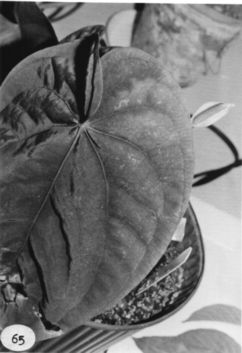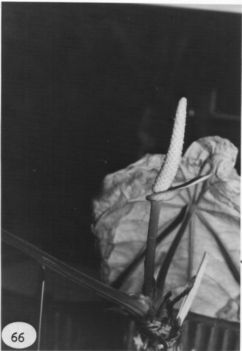



Anthurium dressleri Croat,
Aroideana 1: 54. 1978. TYPE: Panama. Colón: Río Guanche, upstream ca. 5 km above bridge along road to Portobelo, ca. 200 m, Croat 37000 (MO 2395460, holotype; F, K, PMA, SCZ, SEL, US, isotypes; Live at MO).
Terrestrial; stem to ca. 25 cm long, 1-2.3 cm diam.; roots moderately few, brown, slender; cataphylls pale green, to 6 cm long, acuminate at apex, drying brown, persisting at upper nodes.
LEAVES with petioles erect-spreading; blades held more or less perpendicular to petiole; petioles several ribbed, 8-40 cm long, 5-7 mm wide, narrowly to broadly sulcate adaxially (sometimes bluntly medially ribbed), the adaxial surface sometimes purplish; blades narrowly ovate, acute to acuminate at apex, deeply lobed at base, 20-40 cm long, 11.5-30 cm wide, broadest near the middle; anterior lobe 21-32 cm long, the margins convex; posterior lobes 5-10 cm long, sometimes overlapping, often turned up along inner margins; sinus spathulate, often closed, acute at apex; upper surface matte, dark green, velvety; lower surface matte, much paler; midrib raised above, acutely raised below; basal veins (3-)4-5(-6) pairs, free to base, raised above and below; primary lateral veins 5-6 per side, departing midrib at ca. 55¡ angle, raised above and below; interprimary veins flat, darker than surface; collective vein arising from the first basal vein, 4÷9 mm from the margin.
INFLORESCENCE erect, shorter than the leaves; peduncle terete or with several sharp ribs, tinged purple, 7.5-17 cm long; spathe moderately thin, white or greenish white, narrowly ovate to lanceolate, 4.2-8 cm long, 1-3.5 cm wide, broadest in the lower one-third, acuminate to caudate-acuminate at apex, obtuse to cordate at base, inserted at 35¡ angle on peduncle; spadix pale yellow to yellowish green (B & K Yellow-green 9/2.5), 3.5-7.5 cm long, 6-7 mm diam. at base, 4÷5 mm diam. At apex; flowers weakly 4-lobed, 2.5-3.2 mm long, 2.5-3 mm wide, the sides straight to jaggedly sigmoid, ca. 6 flowers in the principal spiral, ca. 10 flowers in the alternate spiral; tepals glossy, weakly punctate, minutely papillate, lateral tepals 0.7-1.5 mm wide, the inner margin broadly convex; pistils green, semiglossy, weakly emergent; stigma ellipsoid, 0.4-0.5 mm long, brush-like with droplets for ca. 1 week before stamens emerge, drying brown; lateral stamens emerging in a rapid sequence from the base, the alternate pairs emerging much later; anthers 0.4-0.5 mm long, ca. 0.8 mm wide, held above the edge of tepals, not completely emergent from beneath tepals; thecae not divaricate; pollen white.
INFRUCTESCENCE pendent, to 13 cm long, 1.7 cm diam.; berries irregularly dispersed, obovoid, dark violet purple in apical one-third, white to greenish below, 6-8 mm long, 5 mm diam., round to mamilliform at apex; seeds 2, 4-5 mm long, ca. 3 mm wide, obovoid, white (turning green in age) one end oblique, enveloped in a semi-translucent appendage. Figs. 65 and 66.
Anthurium dressleri is known from Panama and Colombia in tropical wet and premontane rain forest from 150 to 180 m.
The species is in section Cardiolonchium and is similar to Anthurium crystallinum but differs from that species in having a markedly winged petiole and a concolorous upper blade surface (i.e., lacking whitish major veins). Anthurium crystallinum generally has a terete petiole, leaf blades with prominently paler major veins and, according to Birdsey (1951) and Engler (1905), orange anthers. Folsom 3747, studied live at MO, had yellow anthers. The anthers of A. dressleri are white.
 |
 |
Map of Mesoamerican specimens with coordinates
Panama Panamá: 450 m,, 30 Apr. 1993, Hodel et al. 1247 (MO).